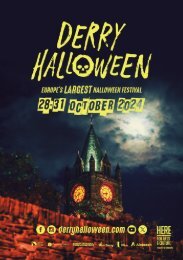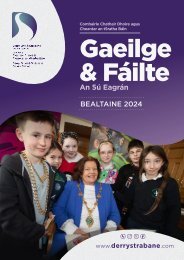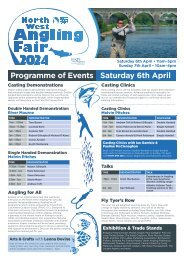Peace IV Newsletter - Autumn Edition 2019
You also want an ePaper? Increase the reach of your titles
YUMPU automatically turns print PDFs into web optimized ePapers that Google loves.
<strong>Newsletter</strong><br />
<strong>Autumn</strong> <strong>2019</strong><br />
Take Back the<br />
“Sit there! Walk properly! That’s<br />
dangerous! Get down! It’s what many<br />
parents tell their kids,’ says Cath McBride<br />
of In Your Space Circus, ‘but there’s value<br />
in letting young people go. It’s powerful<br />
for their development. Our team tell<br />
them how to do thing at are perceived as<br />
dangerous, safely.”<br />
The PEACE <strong>IV</strong> funded project ‘Take Back<br />
the Streets’ has young people doing<br />
exactly that. Made up of 4 elements –<br />
Parkour (Jump NI), Circus (In Your Space<br />
Circus), Dance (Create Dance/Studio 2)<br />
and Graffiti Art (UV Arts) – the project<br />
saw several hundred young people take<br />
over city centre locations for a week in<br />
July. Orchestrated months in advance,<br />
the teenagers had engaged in a series of<br />
specialist workshops. “Everyone wanted<br />
to be spraying, jumping, and tumbling,”<br />
says Cath, “but first we explored themes<br />
like borders. What does it mean to be an<br />
outsider or insider? What are our shared<br />
experiences?”<br />
“I’ve been doing parkour with Jump NI,”<br />
says a lad sitting astride a cannon on<br />
the walls as his friend backflips. “It’s fun<br />
getting to know new friends.” A Circus<br />
Big Top occupies Guildhall Square. Inside<br />
purple light floods yellow sunflowers<br />
and white daisies, red ribbons, trapeze<br />
swings and vaulting equipment.<br />
“We’ve had people from different parts<br />
of the city and country come in. We’ve<br />
been learning about borders. Shared<br />
spaces. Using art to bring people<br />
together,” says a teenage girl. “For<br />
Shared Spaces I feel like they should be<br />
open to everyone, no matter what or<br />
who you are.”<br />
“It has been great developing<br />
collaborations – seeing the collective<br />
passion in arts organisations for peace<br />
and reconciliation,” says Cath. “The<br />
emotive, physical and creative formats<br />
we’ve used have let all kinds of young<br />
people excel.” She speaks animatedly of<br />
youth with ADHD, Autism and one young<br />
participant suffering with anxiety. “She<br />
did circus. Juggling. Skateboarding. We<br />
told her “Go out there and be yourself. If<br />
that’s too hard – be who you want to be.”<br />
It was liberating for her. Life-changing.”<br />
Borders Create Hate. It’s a clear message<br />
from the Graffiti Art teens. They’ve<br />
looked at propaganda posters before<br />
creating their final pieces. “It was really<br />
good to work with people from different<br />
backgrounds you wouldn’t normally work<br />
with,” says one young artist. “Everyone<br />
working together to make something<br />
positive.” He stands by a backdrop of<br />
beanie hats and hoodies, stencils and<br />
freestyle art.<br />
Streets<br />
A young woman from the dance team<br />
agrees. “We’ve been coming up with<br />
choreography – talking about issues like<br />
borders, integrating space and freedom<br />
of expression – then putting our words<br />
and emotions into the routine.”<br />
Physical and emotional contact creates<br />
something powerful between people.<br />
There’s a subconscious team-focus on<br />
commonality rather than difference. A<br />
‘shared space’ in action. “Often youths<br />
socialise in their own wee silos,” says<br />
Emma of council’s Children and Young<br />
People’s team who commissioned the<br />
project. “This project gave them an<br />
opportunity to meet. Respect developed<br />
naturally without authority figures,” says<br />
Cath. “The kids were so invested in it,<br />
had so much ownership, that they acted<br />
as a team, a troop.”<br />
Vaults, acrobatics, tumbles and stilts.<br />
There are many ways to step beyond<br />
obstacles together if you are creative.<br />
Juggling. Applause.<br />
At times this summer, talk of the border<br />
has felt like walking a tightrope - like a<br />
wheel has fallen off the peace process.<br />
Perhaps circus school gives us all<br />
hope that tightrope walking is about<br />
achievable balance. When a wheel comes<br />
off, try unicycling.
Sperrin Heritage & scone bread<br />
“The name Park didn’t show up<br />
until the 20th Century,” says Johnny<br />
Dooher, local historian. He talks of<br />
Traveller memorials, the Tireighter<br />
Stone Ring, Learmount Castle Estate,<br />
An Sagart Ban. Drawings maps,<br />
Photos. After buttered scone bread<br />
and a cuppa in Park Parish Hall,<br />
around 50 people go for the walk<br />
round Learmount Forest Park. The<br />
Sperrin Heritage Walking Trail is part<br />
of the PEACE <strong>IV</strong> One Community<br />
project. Council is rolling out projects<br />
across the entire council area in<br />
partnership with local community<br />
groups.<br />
“One Community is delivered through<br />
urban and rural areas. The Sperrin<br />
area organised a series of walks and<br />
talks in 6 different rural locations –<br />
Ballymagorry, Douglas Bridge,<br />
Plumbridge, Donemana... This is the<br />
3rd walk. It’s about Good Relations,<br />
but also about health,” says Martin,<br />
Council’s project officer.<br />
“People don’t realise the biggest killer<br />
in the house is the armchair,” adds<br />
Leslie from Brighter Ballymagorry<br />
Development Group. “The walks are<br />
a chance to meet people from other<br />
villages we’d never otherwise have<br />
met. That’s how friendships build.<br />
Wonderful what you can learn only a<br />
few miles from your doorstep.”<br />
Leaders in fluorescent Walking for<br />
Health safety vests top and tail the<br />
group. Sunlight sparkles through the<br />
trees of Learmount forest. Rustling.<br />
Birdsong. Hum of voices. An old<br />
Plantation building, Learmount Castle,<br />
emerges through the leaves. In the<br />
1940’s during World War II, evacuees<br />
from Ashleigh House, Belfast came<br />
here. The whole girl’s school was<br />
evacuated from the bombing.<br />
Jane shares story of one lad, Charles<br />
Millbrook, who became the only boy<br />
in the relocated school. Everyone<br />
laughs thinking of the wee English<br />
fella in Derry girls… “The Millers of<br />
Millbrook were big in grain, milk,<br />
electricity. They’d 8 year-old twins<br />
– a boy and a girl – educated by a<br />
governess. When the fancy school<br />
arrived in the local area, both twins<br />
were sent up on the milk lorry to join.”<br />
There’s the ghost stories of the<br />
rattling chains, a carriage through<br />
the forest. Walking, Mary from near<br />
Donemana talks about cutting turf at<br />
the back of Murlough.<br />
“We’re a dying breed,” she says, “but<br />
I love setting the sods in footings to<br />
dry… I saw this project advertised<br />
in the Parish bulletin and thought<br />
to myself – I’d be into that. History<br />
and heritage... We’re from Planters in<br />
Scotland. I think we’d land but they<br />
drank it. I should’ve been Presbyterian<br />
but must’ve got watered down along<br />
the way.” She smiles. “See, we all<br />
have histories… On these walks I’ve<br />
met people from Ballymagorry and<br />
Park. Sure we’ve nothing in common -<br />
except everything.”<br />
“Did ye enjoy the walk?” The banter’s<br />
lively. “Aye, sure. I did it twice. Where<br />
were you?”<br />
“It’s a rural area,” says Caroline from<br />
Learmount Community Development<br />
Group. “We all drive through the<br />
villages, Plumbridge, Cranagh, Park…<br />
but in this project you get a chance<br />
to stop, meet people, hear history. For<br />
that alone, it’s worth it.” She waves<br />
her umbrella vaguely in the direction<br />
of Park Parish Hall. “We could chat all<br />
morning,” she says, “but come on now,<br />
we don’t want soup sticking to the<br />
bottom of the pans.”<br />
Page 2
Connecting Communities<br />
Early September. Spirits are soaring at the Mela - a massive<br />
multi-cultural community event. If you assumed we’re in<br />
Guildhall Square or a public park, think again. Welcome to the<br />
Fountain-Bishop Street interface. “I knew we were making<br />
progress,” says Donna (Bogside and Brandywell Initiative)<br />
when I overheard a shout at Hallowe’en by the dog leg gate<br />
to the interface. “Saoirse! Get back here, the Fountain’s this<br />
way.”<br />
“Everyone was fed up with the orange and green agenda,”<br />
she says. “We recognised the influx of people from around<br />
the world, yet they seemed to be on the periphery.” The<br />
Connecting Communities shared space project set out to<br />
integrate the full diversity of identities around the area. “At<br />
the start you wouldn’t believe how hard it was to get people<br />
out of their areas,” says project worker Seánín, reflecting on<br />
the ‘traditional divide.’ Then there were fears of accidentally<br />
causing offence. “Nobody toul’ me you don’t hug a male<br />
married Muslim,” says Maureen (Pink Ladies), “but I soon<br />
learnt.”<br />
Older residents from both sides of the interface were<br />
fascinated with the Culture Club. “They’d ask the Syrians<br />
what brought you here? The stories were endearing but sad,”<br />
says Donna. Cooking from round the world was popular, but<br />
it took effort to build cross-cultural friendships. “At the start,<br />
people from different countries put wee signs up to explain<br />
their food,” she says. “Now everyone talks.”<br />
Food however, was only the starters. BME communities had<br />
tours of local community services. All communities worked<br />
together in project design. Dialogue, capacity building,<br />
history and heritage were at the heart of programming.<br />
The project emphasised integration and empowerment.<br />
Crafty Corner united residents in craft-making. FUN (Families<br />
Uniting Neighbourhoods) brought families together for a<br />
series of history, heritage and social trips. The LOVE project<br />
trained residents with skills for volunteering.<br />
“Most of our participants had left school at 14,” says Maureen.<br />
“It was the done thing – Catholic or Protestant, you walked<br />
Carlisle Road to the factory. Some never had a certificate<br />
never mind a graduation. They’d barely left the Fountain or<br />
Brandywell.” She recalls participants hearing from a Buddhist<br />
monk about being up a mountain in Tibet. Mind-blowing.<br />
“On a different course some wee ladies had never met a<br />
gay person before. We’d a representative from the LGBT<br />
community who was… let’s say flamboyant. When we were<br />
doing sexual health training there was some craic. Great<br />
camaraderie. Religion and political beliefs didn’t matter in<br />
that room… Our older people did reminiscence. That saying<br />
- wait till ye hear the bars – we found it comes from the shirt<br />
factories! When women had gossip they’d kick the bars under<br />
the sewing tables and head for a smoke to hear the gossip.<br />
And here’s one for you - we were remembering years back<br />
there was a local woman swam in the Commonwealth Games<br />
and the Olympics. Wee Joan from the Fountain sitting in the<br />
room pipes up – it was her. She still has the blazer. One of her<br />
trainers was our facilitator’s Da.” It’s a whole different angle<br />
on cross-community history.<br />
The PEACE <strong>IV</strong> Connecting Communities built on previous IFI<br />
<strong>Peace</strong> Walls and Urban Villages funding. “In terms of shared<br />
space,” says Donna, “we’d progressed, but we needed more<br />
events. Initially some people refused to go to the Fountain<br />
out of fear. After reassurances they did and found a great<br />
welcome. We’ve found a changing attitude. When we plan<br />
events or bus pickups we don’t have to say in advance where<br />
they’ll be. There’s a willingness to go wherever we can get a<br />
space… open doors now for residents from across the area to<br />
access services. People are moving more freely.”<br />
Page 3
CultureFuse<br />
The clue’s in the title. The project<br />
links Irish, Ulster Scots and Marching<br />
Band cultures. “The dialogue is always<br />
between everybody. From conception<br />
to design,” says Catherine from An<br />
Cultúrlann. In the ‘traditional Norn Irish’<br />
sense, you’d struggle to find a more<br />
diverse collective. Members include<br />
the North West Cultural Partnership<br />
(Walled City Tattoo, Londonderry<br />
Bands Forum, Bready and District<br />
Ulster Scots, Blue Eagle Productions,<br />
Bob Harte Memorial Trust, Sollus<br />
Highland Dancers) and Irish Cultural<br />
representatives (An Cultúrlann, Oideas<br />
Gael) and St Johnston Orange Lodge<br />
LOL992 from Donegal. “We’ve learnt<br />
a lot about collaborative work,” says<br />
Catherine. “When there’s fears or<br />
difficulties, discussion and reflection<br />
has helped relationships.”<br />
Music flourishes. Traditions meet.<br />
Pipers, fluters, singers, drummers - Irish,<br />
African and marching band musicians<br />
routinely collaborate. “You build on<br />
what you love,” says Catherine, “not<br />
around what you disagree on.” At a<br />
packed cross-community event in<br />
St.Johnston Orange Lodge, love of<br />
dance, drama and music is evident.<br />
Despite its positive community<br />
contribution, the Donegal Protestant<br />
community has sometimes felt isolated,<br />
misunderstood. Keep your head down…<br />
don’t rock the boat... In the New Gate<br />
Arts Fringe Festival heads are raised.<br />
Songs as gaeilge sound alongside the<br />
William King flutes and Thiepval pipes.<br />
The heat of border politics is of less<br />
concern than the heat in the room<br />
affecting musical tuning.<br />
Before CultureFuse one young clarinet<br />
player had never performed beyond<br />
school and his local marching band.<br />
He was for changing his degree<br />
choice from music to business. He<br />
almost phoned in ‘sick’ before a first<br />
Traditions Meet performance in Bready.<br />
Afterwards, he emerged grinning, his<br />
confidence as a musician massively<br />
boosted. “I’d never heard him sing,”<br />
says Catherine, “But a different day<br />
we’d a group of former soldiers in – big<br />
strapping 50 plus men who’d served in<br />
Derry. The same lad sang The Parting<br />
Glass and spoke of his Granda dying<br />
and the song’s significance. Once he<br />
shared, it was unbelievable how the<br />
former soldiers opened up, tears and<br />
all.”<br />
Highlighting 100 years of women in arts<br />
and culture was the theme of Common<br />
Threads, a textile arts exhibition. Its<br />
colourful panels graced Waterside and<br />
Cityside venues. Recently, the Holland<br />
Memorial Lodge, the only ladies lodge<br />
in the Cityside, have engaged to tell<br />
their stories and a further collective of<br />
artists – from poets to woodcarvers,<br />
conventional to digital artists, have<br />
worked together on sustainability.<br />
For language, the context hasn’t been<br />
easy – Stormont suspension, Irish<br />
Language Act issues. “Politics returned<br />
people to silos,” says Catherine. “How<br />
do you talk about Irish language<br />
outside politics?” In CultureFuse,<br />
place names have attracted a ‘nontraditional’<br />
audience. A trip to the<br />
Scottish Gaeltacht showing Gaelic<br />
fused into British Presbyterian identity<br />
in church, war memorials and Rangers<br />
Supporters clubs was eye-opening. One<br />
participant confessed his granny had<br />
been a fluent Irish speaker… Another<br />
participant first engaged because his<br />
granny, a gaeilgeoir (Irish speaker) had<br />
stopped speaking Irish when working<br />
for landed gentry. In old age with<br />
dementia, she’d reverted to Irish and<br />
her family couldn’t understand her.<br />
“Give people an emotive connection, a<br />
reason, and they’re more likely to learn,”<br />
says Catherine.<br />
The ‘Say focal’ (it means word…) series<br />
of talks transformed attitudes and<br />
shared space. Initially venues were wary,<br />
but events were held in Protestant<br />
communities and churches. “Very<br />
negative” was a common response<br />
on initial tick box questionnaires on<br />
attitudes to Irish Language. ‘Very<br />
positive’ the more common post-event<br />
response. “I didn’t know any of that<br />
information,” wrote one participant.<br />
“Given a chance, people don’t conform<br />
to green and orange boxes,” says<br />
Catherine. “We need funders to<br />
measure success differently. Inclusively.”<br />
The project is edgy. Dynamic.<br />
Progressive. Like so much peace work,<br />
it needs ongoing resourcing. “With this<br />
type of work,” she adds, “you can’t take<br />
your foot off the pedal.”<br />
Page 4
Don’t Shoot My Wane,<br />
Shoot Me!<br />
There is a bravery about some peace<br />
work that deserves acknowledgement.<br />
April <strong>2019</strong>. Creggan. Shantallow.<br />
Bogside. Caw. The programme bills<br />
Don’t Shoot My Wane, Shoot Me! as<br />
a “powerful new immersive drama<br />
production highlighting the issue<br />
of punishment beatings and the<br />
dehumanising nature of such attacks<br />
on both victims and perpetrators.” It<br />
doesn’t disappoint.<br />
Jason sits in front of us in a cheap<br />
tracksuit. Eyes-flitting. Nervous. Jimmy<br />
swaggers late into the community<br />
meeting, “Word to the wise, kid. It’s<br />
a done deal. You’ll not get much<br />
sympathy round here.” From the off,<br />
we’re in the thick of it. The characters,<br />
the meeting, feel real.<br />
“The case we’re gonna be dealing<br />
with tonight is the incident with<br />
wee Mrs McGinley,” says Maggie,<br />
the Community Worker. She holds<br />
up a photo of a battered old lady,<br />
hospitalised after a robbery. “There’s<br />
been calls all over social media for<br />
street justice… As a community we’re<br />
going to take a vote… A simple yes or<br />
no.”<br />
Jimmy elaborates “You just tell the<br />
people here why you shouldn’t be shot<br />
in the f****** legs,” he tells Jason. “Then<br />
when you’re done, I’ll tell them why<br />
you should.”<br />
“It was an accident,” says Jason, “I’d<br />
a drug debt, so I lifted the purse.”<br />
Heckles. Supportive jeers. Different<br />
characters speak from amidst the<br />
audience.<br />
“My nerves are just shattered…” says<br />
Jason’s Mammy. “He’s been a bother<br />
since he was 11…”<br />
“Jason was first sent to me when<br />
he was 14,” says his social worker.<br />
“possession… cannabis at the time…”<br />
“Twenty times he’s committed an<br />
offence and been back out on the<br />
streets again. Is that justice?” says<br />
Jimmy.<br />
Jason has already filled in his DLA<br />
forms. He seeks clarification - one leg<br />
or two? He’s had a troubled life. “So it’s<br />
society’s fault?” says Jimmy. “Society<br />
that robbed Mrs McGinley and left her<br />
in a pool of blood?” Jimmy claims to<br />
be protecting the community. “Who<br />
gave you that power?” asks the social<br />
worker. Planted taunts - shoot him,<br />
shoot him… We are shown screens<br />
of real life social media support for<br />
punishment attacks.<br />
Jason’s eyes go down. He sits. Quiet.<br />
We learn Jason’s father jumped the<br />
bridge when Jason was 11. Now Jason<br />
has a son. Kitty, Jason’s mother<br />
speaks. “I told him I wanted him shot. I<br />
told him to take his oil. Can you credit<br />
that? …Who are we under threat from<br />
here anyway? You’re the only one I see<br />
waving guns about here. Why don’t we<br />
give Jason a break? Shoot me instead<br />
of him!”<br />
Jason wrings his beanie hat through<br />
his fingers. “I’d just like to apologise.<br />
Whatever you’s decide tonight, I’ll<br />
go along with it.” There is a blurring<br />
between fact and fiction. Maggie calls<br />
us to reflect. “Think hard about it. The<br />
vote that you give either to shoot<br />
or not shoot – that is the message<br />
that we as a community are sending<br />
out to the rest of the world.” There is<br />
applause. We’re thanked for listening.<br />
We queue to vote. 15 minutes later a<br />
live count is conducted. “No, yes, no,<br />
no, no.” The final tally is 16 yes, 71 no.<br />
Over the last decade 833 people have<br />
been shot (287) or beaten (546) by<br />
so-called paramilitaries in Northern<br />
Ireland. From February 2018 –<br />
February <strong>2019</strong> 72 people were victims.<br />
1 in 5 faced amputation or walking<br />
with a limp for the rest of their lives. 3<br />
people died. The average cost of each<br />
attack to the NHS A&E was £91,362.<br />
In each of the four venues the play<br />
toured, the audience strongly voted<br />
against punishment attacks. ‘Don’t<br />
Shoot My Wane, Shoot Me!’ is a<br />
Greater Shantallow Community Arts<br />
(GSCA) project, written and directed<br />
by Ronan Carr. For further information<br />
contact Ollie Green, Arts Director<br />
(GSCA).<br />
Page 5
Opening Doors For <strong>Peace</strong><br />
“Sometimes in rural areas it’s<br />
easier to be insular. You don’t just<br />
walk down the street and bump<br />
into diversity. You’ve to purposely<br />
go out of your way to integrate,”<br />
says Caroline from RAPID (Rural<br />
Area Partnership Derry).<br />
When the project first landed<br />
on her desk she thought it<br />
said 15% Black and Minority<br />
Ethnic Participants, not 50%.<br />
‘Intercultural Pairing’ was about<br />
more than linking Catholics and<br />
Protestants, it included wider<br />
identities. It required thinking<br />
outside the box.<br />
From September 2018 – March<br />
<strong>2019</strong>, 60 children aged 6 – 13 met<br />
weekly in Newbuildings. A diverse<br />
collective. Participants hailed<br />
from the Mandarin Speakers<br />
School, Extern, NW Islamic<br />
Group, Destined, The Women’s<br />
Centre Multicultural Group,<br />
Claudy Brownies, Park Art Club,<br />
St. Colmcille’s PS, Enagh Youth<br />
Forum and Newbuildings Youth<br />
Club. “I have loved, loved, loved<br />
taking part in these activities,”<br />
says Kayla from Claudy.<br />
“Especially since I met my new<br />
best friend, Chelsea.”<br />
The project wasn’t always plain<br />
sailing. “Parents of children with<br />
learning disabilities weren’t<br />
initially sure if their children<br />
would be able to get involved,”<br />
says Caroline. “I could also sense<br />
a reluctance from other parents<br />
about going to Newbuildings.” On<br />
the first night, some of the girls<br />
from Enagh refused to get off the<br />
bus. “Look at the flags… There’s a<br />
fella in a Rangers top…”<br />
English language skills were a<br />
barrier with Syrian refugees.<br />
Some Newbuildings residents<br />
were initially concerned about<br />
Gaelic football being played<br />
in their local community<br />
centre. Good listening and<br />
communication won many small,<br />
significant, victories. People got<br />
off buses, took part, talked, made<br />
friends and became supportive.<br />
“I was pleasantly surprised,” says<br />
Caroline. “It was positive to see<br />
the change.”<br />
Activities included Gaelic/Soccer,<br />
Tai-Chi, Multi-cultural Cooking,<br />
Rugby and T-shirt printing.<br />
“We really enjoyed teaching local<br />
children Tai Chi and Chinese<br />
Culture. They loved it,” says Yang<br />
from the Mandarin Speakers<br />
Association. Celebration of<br />
the Chinese Moon Festival<br />
with traditional sweets, cake<br />
and painting dragons proved<br />
popular. “The kids went mad<br />
for the cooking,” says Caroline.<br />
“Italian, Indian, Pancake Tuesday…<br />
everything had a story behind it.<br />
It wasn’t just here, have a bit of<br />
pasta…”<br />
She recalls a Newbuildings<br />
lad helping a Syrian boy with<br />
learning difficulties to learn<br />
T-shirt printing. “The drawings<br />
on the t-shirts had to represent<br />
something important in their<br />
identity, their community,”<br />
she says. “I could see a real<br />
connection between them<br />
despite the language barrier.<br />
They were drawing a Syrian flag.<br />
Ah, yer mammy’ll be real happy<br />
with that.”<br />
Gaelic, Soccer and Rugby<br />
surpassed expectations. “We got<br />
involved because Newbuildings<br />
is a rural community. Most<br />
people stay local, play local and<br />
don’t tend to mix with different<br />
communities or cultures,” says<br />
Sean from Newbuildings Youth<br />
Club. “Some of the boys have<br />
even missed football training to<br />
be here tonight. They’re in the hall<br />
playing Gaelic. Unbelievable.”<br />
In May, the project finished with<br />
a trip to Carrowmena. “Funny,”<br />
says Caroline, “we weren’t<br />
pushing the peace project thing,<br />
but as friendships grew, so did<br />
conversations. How come you<br />
ended up here? I heard a girl<br />
asking a Syrian friend. When<br />
How come you’re not eating<br />
a bun? turns into a Ramadan<br />
conversation, you know curiosity<br />
and trust has beaten prejudice<br />
and polite silence.”<br />
The project’s legacy is an opening<br />
up. Of minds. Of hearts. Of<br />
communities. “One of the houses<br />
I’d go to collect weans from, I was<br />
never invited in,” says Caroline.<br />
“Curtains would flicker. The kids<br />
came out. On the morning of the<br />
final celebration the door was<br />
opened. I was welcomed into the<br />
house.”<br />
Page 6
PEACE <strong>IV</strong> In Pictures<br />
PEACE <strong>IV</strong> Networking Event<br />
Gaslight, Churches Trust,<br />
Rosemount Resource Centre<br />
Waterside Shared Village (WNP)<br />
Shared Space (Shepherd’s Glen,<br />
Bond Street, Triangle)<br />
LEAD Project (HURT)<br />
Celebrating Common Christian<br />
Heritage (Churches Trust)<br />
Strabane Shared Spaces Project<br />
(Holywell)<br />
CultureFuse Sustainability Project<br />
(An Cultúrlann)<br />
PEACE <strong>IV</strong> Project (Playhouse)<br />
One Community – Faughan –<br />
Kayaking (RAPID/DCSD Council)<br />
Youth Zone Launch<br />
(GDi/DCSD Council)<br />
Government Ambassadors’<br />
Programme (DCSD Council)<br />
Page 7
Are you taking part yet?<br />
There is something for everyone in our Council PEACE <strong>IV</strong> Programme. Why not get<br />
involved and support peace in person? Contact us – we’re happy to help direct you to<br />
something that meets your interests.<br />
Want more information?<br />
Sign up for our monthly e-bulletin at www.derrystrabane.com/<strong>Peace</strong>-<strong>IV</strong> or<br />
browse our website.<br />
The PEACE <strong>IV</strong> Team can be contacted at:<br />
Email: peace@derrystrabane.com<br />
Tel: 028 71 253 253<br />
A project supported by the European Union’s PEACE <strong>IV</strong> Programme, managed by the Special EU<br />
Programmes Body (SEUPB).<br />
Page 8

















